
Steven and I realized quickly yesterday on our first day on Huahine that we needed to rent a car for the next two days in order to really get to know the island and not be bored out of our wits as there was little to do around our rental property. We were very lucky that our property owner had two extra cars he rented out to his guests and we appreciated he didn't try and gouge us at all even though we were at his mercy.
Driving around the winding coastline of the bay, we took a moment to look back at the Seventh-day Adventist Church we'd seen yesterday.
Chickens and roosters seemed to have free rein on Huahine and, we'd find out soon, on the other islands as well! No need for alarm clocks, that was for sure.
There was little sand on the beach but more dead coral than I'd ever seen in my life. It was fun searching for interesting-looking shapes.
The island of Huahine is split up into two mountainous masses, with Huahine-Nui, the large island, located in the north, and Huahine-Iti, the small island, in the south. Huahine is part of the Leeward Islands and, with the Windward Islands, constitute the approximately 17 million-year-old Society Archipelago. The masses are connected by an underwater isthmus that partially appears at low tide.
Huahine-Nui owes its formation to the birth of a volcano. Another volcano, the youngest of all, developed in the caldera of the former. The island's highest summit is 669-meter-high Mount Turi, located on its crater-shaped tip. Huahine-Iti, the older part of the island, was born from a volcano from which the lava came out of two distinct chimneys.
Stunning flowers almost completely covered the front lawn of this home.
On the north side of the island was the shallow expanse of Lake Fauna Nui also known as Lake Maeva, which was actually an inlet from the sea.
The principal natural wealth of the northern coast of Huahine was made up by the vast Fara Nui lagoon that's connected to the ocean by a narrow arm of the sea. The lagoon was protected from the powerful waves of the Pacific and wasn't sensitive to the northerly and easterly breezes. As a result, it was almost like a lake with calm water with lots of crabs, cockles, and fish.

Evidence of human habitation on Huahine going back at least 1,300 years ago has been found by archaeologists with the village of Maeva occupied as early as 850 AD. Hawaii's Bishop Museum recorded 54 maraes on Huahine in 1925 with most of them built after the 16th-century. An additional 40 maraes were discovered in 1968. Huahine was divided into 10 districts with its smaller adjacent island, Huahine-Iti, as a dependency. Maeva, located on the south shore of Lake Fauna Nui, is unique in all of French Polynesia because here all the Huahine district chiefs lived side by side and worshipped their ancestors at their respective marae, 28 of which were recorded here. The great communal marae at Maeva included 16 that have been restored.

The marae was the place reserved for ceremonial activity in both the social and religious realm for the ancient Polynesians. At the end of the 18th-century, they were monuments of imposing size which aroused the interest of early European explorers. Though the layout and construction of the maraes varied from one island to another, the architectural standard was a rectangular structure with a court on which was built a platform or ahu at one end.
In the 1970s many of the structures strewn along the lakeshore and in the nearby hills were restored. On the shores of the lake was Fare Pote'e, an archaeological museum, that was set up as a replica of an old meeting house.
A sign indicated the dimensions of the community hall or fare related to the social importance of its occupants. They usually ranged from 10-15 meters in length and 6 to 7 meters in height with the total surface reaching 100 square meters. Old dwellings were normally round but the rectangular shape of the habitats was assumed to have been related to the settlement of an egalitarian society.
The museum attendant told us the ceiling was constructed of calabash leaves and the floor from bamboo. To protect the latter, we had to remove our shoes before entering.
A meeting house built on pylons remained for more than a hundred years close to the temple at Maeva before it was renovated in 1972 and again in 1996 when it was removed to this present location.
After the introduction of the French Protectorate in the French Polynesian islands of Tahiti and Moorea in 1842, the context of rivalry between the English and the French lead Governor Armand Bruat to extend his control over the Leeward Islands. At the end of 1844, taking advantage of the lack of the most influential leaders of Huahine, the French appointed a chief, Haper'a, as the supreme leader as he was known for his weak resistance to the colonizers.

After the pro-French chief was deported when Queen Teri'itaria returned, it made an attack imminent. After an ultimatum in early 1847 demanded the return of the pro-French chief, the Uranie frigate bombarded and burned the village but couldn't overcome the resistance of the Huahine people. A French-English agreement on the Leeward Islands in 1847 allowed Huahine to avoid the 'protectorate' of either or both powers. Huahine's inhabitants, however, subsequently became full citizens of France in 1946 after previously being 'simple subjects.'
The village of Maeva and its outskirts had been the de facto capital of Huahine before the arrival of the Europeans. It was the place of residence of the ari'i families of Huahine. According to oral tradition, there were eight leading families from the same lineage and all were established in the northern part of Huahine-Nui.
Each clan chief had a seat at the marae on Mata'orea Hill where remnants were discovered. Such a concentration of the dominant clans which shared the island in only one place was unique among all other French Polynesian islands.
The only other sight to see in the village was Maison de la Vanille or House of Vanilla which I wanted to stop at as French Polynesia is famous for its vanilla production. However, it was barely worth the stop for its bored employee who couldn't have cared less that we were interested in knowing about their vanilla production and their products for sale.
Of course, the largest and snazziest building in the tiny village of Maeva was the Seventh-day Adventist Church!
By the part of the channel closest to the lake, we encountered aua i'a or V-shaped fish parks that acted as traps where fish enter at low and high tides where they are caught with a landing net or harpoon. It's believed the rock traps were built in very remote times when eight clans ruled over Maeva. They were kept in good repair by the clans' descendants and only restored in 1880. With the progressive establishment of the French administration by 1890, the lake and its shore became public property.
Sadly, the traps deteriorated when the traps' maintenance wasn't carried out correctly after being left at the disposal of the inhabitants. Fortunately, some of the traps are again operational. The tips of the Vs point toward the ocean with the long stone arms visible above the water level.
Just across the bridge to Motu Ovarei was a hill on which had been planted lovely tropical flowers. A motu is the word for a Polynesian reef islet with vegetation.
Another of the fish traps:
Accessible via such a very rocky road on the motu that I wondered if it were safe for our rental car to be on was another archaeological site, Marae Manunu. The massive structure was 2 meters high, 40 meters long, and almost 7 meters wide. It also featured a two-stepped platform or ahu. The marae was mostly dedicated to Tane, the island's god of war and fishing.
We made sure to find a place to park that wasn't under any palm trees unless coconuts would fall and damage the car. If you're familiar with the vegetation of French Polynesia, you'll know that's not an easy feat!
At the southern tip of Motu Ovarei were the remains of the defunct Sofitel Resort. The reason we'd driven to this rather godforsaken spot was to snorkel in what was described as the Garden of Coral. After managing to find a spot to park where hopefully coconuts wouldn't damage the car, we wandered toward the water not having any idea where the coral beds were as, we soon realized was typical of sights in French Polynesia, there were no signs.
We weren't sure but thought and hoped the best snorkeling would be found around the former overwater bungalow pylons.
The coral beach:
Thanks to our youngest son's generosity, this was the first time we had an underwater camera to capture the beauty and wonder of the sea. He'd remembered that years ago we were so bummed not to have had a camera when snorkeling off Australia's Great Barrier Reef.
We were so thrilled to have permanent reminders of the magnificent coral even if there weren't the profusion of fish we imagined.
Each of the dark spots was an indication of coral and another place to explore. The water was very clear and since there were no other snorkelers, the experience was just about perfect that afternoon.
Another reminder of the former resort was probably what was an old hot tub next to the water. I could just imagine what an idyllic sight that must have been lazing in the hot tub with palms swaying in the breeze and looking out at the turquoise waters.
After a couple of hours, we left to drive around the rest of Huahine.
On the way back to the mainland, we stopped at Gallery Umatatea that is known for its "exotic paintings of the highly respected Melanie Dupre." The gallery couldn't have had many visitors because we never saw the artist or an employee while we walked around. Thank goodness there wasn't anything we wanted!
As we continued the island drive, we saw a sign that was too tempting to refuse - a free boat ride over to a pearl farm in the middle of Faie Bay! Pearl farms, like vanilla farms, are a big, big thing in French Polynesia so getting the chance to visit one was not one we wanted to miss.
Dead ahead was the pearl farm, certainly not a farm like any we'd seen before!
The 'farm' was actually a shop in the middle of the water where we learned all about pearl cultivation and, oh yes, got to see the farm's selection of pearls.
Unfortunately, the presentation was as boring as all get out and I wasn't inclined to support the shop.
The pearl 'farm' also had an extensive hand-crafted pottery collection but the prices were obscenely expensive so we didn't take more than a quick look.
Even if the pearl farm was less than we'd hoped, the boat ride there and back made up for it. We didn't know the protocol about whether to tip the boatman since he didn't earn a commission from a pearl sale but we opted to thank him tangibly since he had no other potential sales then.
A few kilometers beyond the bay in the village of Faie was a chance to see Sacred Blue-Eyed Eels in a very shallow river. As you likely figured out by now, the dominant language in the islands is French. Fortunately, I have retained a decent comprehension of French and the ability to speak it from having lived in the French-speaking area of Switzerland decades ago.
The four-to-five-feet long eels were considered sacred by the locals. In the past, mackerel could be bought from a roadside stand to feed the eels but the stand had closed down at some point. We instead fed them with bread which they didn't appear to object to.
We didn't see any evidence of it but apparently, the eels could climb up the concrete bank if food were nearby. I'm not sure if I would have loved that or been scared out of my wits to see the eels come up right by us!
Steven and I were so happy we'd made the decision to rent the car as the more we saw of the island, the more intrigued we were with its stunning views.
From the Belvedere or lookout near Huahine-Nui's highest point, it was a scary 30% downhill grade.
It was a little hairy reaching the winding coastline again as the island's roads weren't quite up to snuff as compared to North American standards.
Crossing over to Huahine-Iti, the smaller island, afforded us more views that made us drop our jaws they were so spectacular.
The most gorgeous sight on the island had to be the view from the Tefarerii Panorama on the east side of the island. If a scene like this doesn't scream tropical paradise, I don't know what does! Tefarerii, which meant House of the Kings, was home to Huahine's most powerful family a century ago. I read that nowadays the inhabitants of the small village of Tefarerii - it was so small we didn't even see it! - spend their time fishing and harvesting watermelons and other produce on a nearby motu.
On the island's southern tip was Marae Anini, a comparatively recent construction that was dedicated to the god of war, Oro, and the god of thieves and sailors, Hiro.
Yet another Seventh-day Adventist Church on the island!
The island drive was definitely a highlight of our time on Huahine as it allowed us to see some OMG sights. It did reinforce, however, how very poor the island was in terms of housing, and almost no stores of any sort, and absolutely no place to stop to get a bite to eat or drink anywhere at all outside of Fare, the town on the north island near our rental property.
Later that day we drove from our rental property just half a mile or so up the road to a lovelier beach than we'd found earlier on the motu.
What made the experience even more special was some local men had also stopped under the shade of the palm tree to play some beautiful Polynesian music for an hour or so. Imagine being serenaded while lollygagging on a coral-filled beach in the South Pacific. As Steven and I so often say to each other, it doesn't get much better than this. This was certainly one of those times!
There were no shells I noticed on the beach but even more exciting was these pieces of dead coral in all sorts of unusual shapes.
Photos from the next day, December 4th, as we again drove around part of Huahine and snorkeled at the former Sofitel Resort.
Eden Parc:
Maroe on the southern part of Huanine-Nui:
Maroe Bay:
I'd read that Huahine was known for its surfing but we didn't see any surfers or even spots that seemed viable surfing locales.
Back at the former Sofitel Resort for more snorkeling:
As I mentioned in the previous post, a lot of groceries in French Polynesia were anything but cheap. A loaf of the least expensive sliced bread was an eye-popping $7. For Steven, that was well worth it as he loves toast in the morning! Hamburger buns were $5.
The food trucks back in the island's main town of Fare were a welcome break from having to cook.

Next post: Adieu Huahine et bonjour Raiatea!
Posted on January 3rd, 2022, from our home in Denver as Omicron is sadly marching on unabated all around us. Steven and I hope that you and your loved ones are safe from the scourge and are enjoying the first days of this new year.






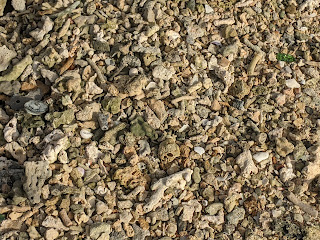



















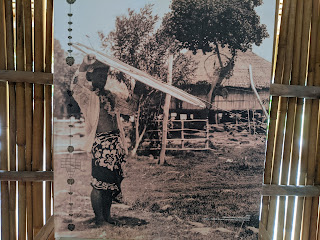
















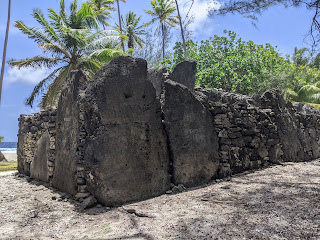




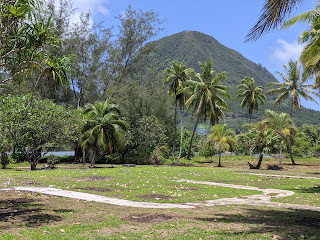
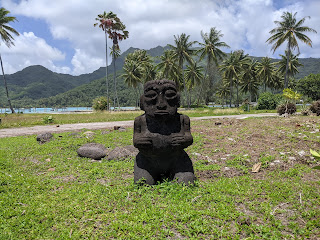

















































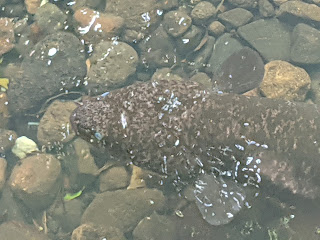






















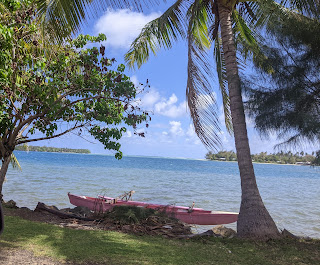

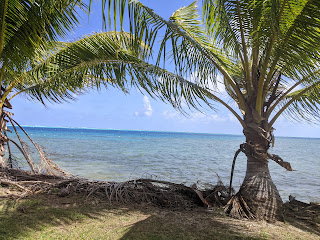

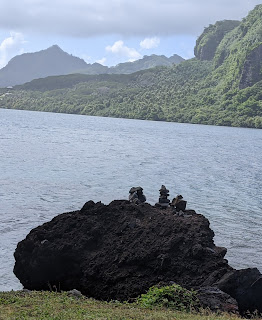

















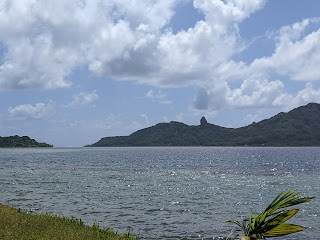
































Your underwater photos are stunning ! What a great gift from your Z. xo Lina xo
ReplyDeleteHow VERY lucky we were to have the generous gift from Zachary as you said, Lina!
ReplyDeleteI agree the underwater camera did good. Janina
ReplyDeleteGlad you liked them, too, Janina.
Delete